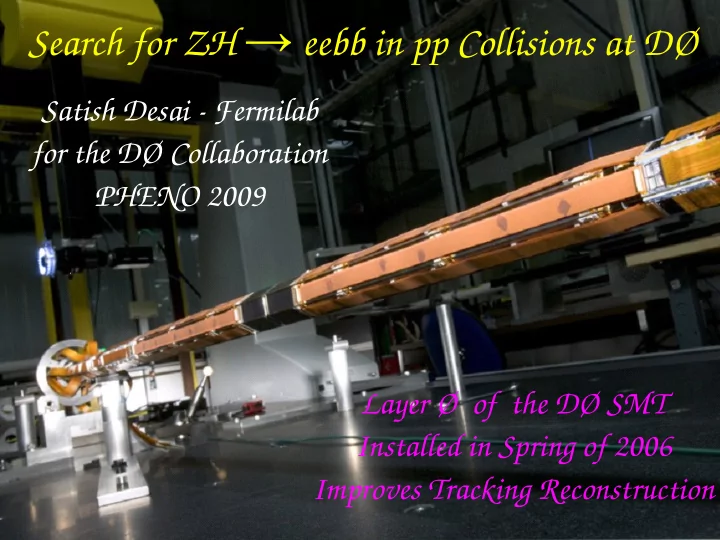

→ Search for ZH eebb in pp Collisions at D Ø Satish Desai - Fermilab for the DØ Collaboration PHENO 2009 Layer Ø of the DØ SMT Installed in Spring of 2006 Improves Tracking Reconstruction Satish Desai - 11 May 2009 1
Introduction Excluded m H (GeV) H bb → H WW → → ● At low masses, H bb is dominant decay mode ● Multijet production of bb makes highest cross section process hopeless ● Search in association with Z (or W) decaying to electrons (or other leptons) Satish Desai - 11 May 2009 2
Needles and Haystacks Process BR(fb) Z(→ee) 755,000 Z(→ee) +HF 18,100 Both exclusive Z tt→e e bb 72.9 and Z + light jets Diboson →ee+jets 310 ZH →eebb 2.65 At M H =115 GeV ● Also need to contend with the multijet background ● Very difficult experimental challenge ● Simple counting experiment is not sufficient Satish Desai - 11 May 2009 3
The Strategy ● Final statistics will be low ● Keep selection as loose as possible ● Attempt to maximize efficiency ● Develop a multivariate discriminant to further separate signal from background CC ICR ● Split data into orthogonal sub-channels (electrons, bid) ● Extract limits (or discovery!!) EC from shape of output distribution Satish Desai - 11 May 2009 4
Event Selection ● Require two jets with | | < 2.5 CC-CC + CC-EC ● Leading jet p T > 20 GeV Zjj selection ● 2 nd jet p T > 15 GeV ● Neural net based b-tagging ● Orthogonal samples with one tight or S/√B = 0.02 two loose tags ● Two electrons with p T > 15 GeV ● CC-CC Z+2 b-tags ● CC-EC CC-ICR ● CC-ICR ● 70 GeV < M ee < 110 GeV Satish Desai - 11 May 2009 5
B-Tagging Performance Loose Tight Choose operating point by cutting on neural net output Satish Desai - 11 May 2009 6
A Fully Measured System ● Exploit fact that we reconstruct all final state particles ● Use a kinematic fit: ● Vary jet, electron energies and angles within uncertainties ● Constrain M ee to Z mass ● Constrain total p T of eejj system to zero ● Not done (yet) for ICR channel S/√B = 0.06 Satish Desai - 11 May 2009 7
Multivariate Methods ● Use a boosted decision tree ● Combine information from many variables with CCCC + CCEC discriminating power 2 tags M H =115 GeV +... Satish Desai - 11 May 2009 8
Systematics Source Size (%) ● Categorize systematics that change: Luminosity 6.1 ● Normalization only Electron ID Efficiency 2.0-3.5 ● Differential distribution of Jet ID Efficiency 2 the BDT discriminant Jet Energy Resolution 2.5 Multijet BG Modeling 2 BG Cross-sections 6-20 Source Size (%) Jet Energy Scale 10 B-Tagging Efficiency 9.7 Mistag Rate 4.7 B-jet Fragmentation 0.5 Z+jet modeling 3.6 Jet Track Matching Efficiency 3 Satish Desai - 11 May 2009 9
Results ● Limit / SM Cross Section at M H =115 GeV ● 15.3/18.7 Exp/Obs in CC+CC CC+CC ● 57/68 Exp/Obs for CC+ICR ● Combination with muon channels in next talk ● We are fast approaching a 6 fb -1 dataset ● Expect to analyze 10 fb -1 by the end of Run II CC+ICR Satish Desai - 11 May 2009 10
Outlook ● Also working on improvements to the analysis ● Apply kinematic fit to ICR channel ● Improvements to jet energy resolution – M bb still the most powerful variable ● Reduced systematics ● Addition of a Matrix Element discriminant ● Use differential cross sections convoluted with resolutions to produce signal and background likelihoods ● Has proven a powerful tool in top analyses The Higgs search at the Tevatron is getting more exciting all the time! Stay Tuned!!! Satish Desai - 11 May 2009 11
Backup Slides Satish Desai - 11 May 2009 12
CCCC+CCEC Event Yields Satish Desai - 11 May 2009 13
CC-ICR Event Yields Satish Desai - 11 May 2009 14
Recommend
More recommend